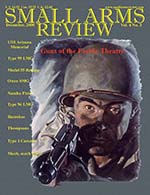Firing the Nambu Type 14, Japan's Service Pistol
By Bob Campbell
Perhaps the most deprecated of all World War Two handguns is the Japanese Nambu. It has been described as a handgun manufactured by a nation with no handgun heritage, or a gun made before we knew what a combat handgun was all about. As a fighting pistol the Nambu doesn’t have much to recommend it, but it is certainly not a piece of junk, nor is it ironmongery. The Nambu is a better gun than many of the .30 and .32 caliber handguns available for military use in the 1930’s and probably as good as some handguns with a much better reputation. On the other hand, it is easily understood why Japanese officers attacked with the sword, not the Nambu, at close range!
I would much prefer several earlier Japanese service guns to this one, namely the various Smith and Wesson breaktop revolvers in .44 Russian caliber which the Japanese purchased. ( I have seen one Russian Model, with Cyrillic characters, which was brought back by an American serviceman from Iwo Jima. Perhaps it was originally captured by some worthy ancestor during the Russo-Japanese conflict?) The earlier 8mm double action revolver, which sometimes produced a muzzle velocity of 400 fps was even worse!
Yet, Nambu produced an excellent light machinegun, so we are left with the conclusion the Japanese didn’t think pistols were very important. I cannot find a reliable account of an Allied soldier being killed by a Japanese pistol in combat, although it must have happened.
The Nambu is a semi-auto pistol similar in manipulation to the modern Ruger .22 caliber pistol. A large cocking knob on the rear of the bolt makes cocking the gun quite easy. Ejection is straight out of the top, making the Nambu left or right hand neutral. The safety would be more handy to a left handed shooter, or “molly dooker” as the Australians say it, but by no means handy to either. The pistol features dual recoil springs which are not needed for the caliber. This pistol was in use for some time, and it was possibly the first general issue Japanese semi-auto. The solid S curved gripframe fits most hands well. Although the gun is bulky it is thin in the gripframe to allow use by those with small hands. The triggerguard was enlarged from earlier pistols as a result of action in frozen Manchuria, as the gun saw use in China. With the enlarged triggerguard the gun is quite handy for gloved hand use. I would not wish to use the 8mm Nambu against a heavily clad adversary, however. There is a chance the small caliber low velocity bullet would not penetrate thick winter clothing or web gear.
The Nambu incorporates a magazine safety that prevents the gun from firing if the magazine is removed. This is considered an excellent safety measure for troops, many of whom are uninterested in firearms safety. The manual safety is located on the left hand side of the frame and very difficult to use in a hurry. I suspect most Nambu’s were carried chamber empty, being charged as they were needed. The Nambu has a Browning type magazine release. However, there is a curious device near the bottom of the gripframe which prevents the magazine from dropping if the magazine release is struck - the magazine must be slipped loose, not allowed to fall free. Combined with the follower into the bolt type bolt hold open design, it was not easy to quickly reload a Nambu in combat! The Nambu is not without good features. The sights are unusual but better than many of the period.
I was surprised at the quality of the trigger action. I have learned to begin trigger compression at the top or bottom of military pistols to combat heavy trigger actions. The Nambu pistol’s trigger is very clean, breaking at about two pounds. This is too light for a military weapon by most standards but certainly would make good shooting possible.
I was able to fire the gun with custom 8mm Nambu ammunition from the Old Western Scrounger. The bottleneck 8mm Nambu is no hot rod round. The bullet probably weighs about 85 grains, and muzzle velocity is 1,050 fps. The standard military round has a jacketed bullet weighing approximately 102 grains. I would prefer the 7.62mm Tokarev to this caliber. Recoil is light. The light trigger and good sights, as well as a solid mating to the frame, produced decent accuracy. I was able to secure several 2 inch groups at 50 feet. I have to admit this is an enjoyable gun to fire. You can empty the eight round magazine quickly, with good results predicted on the target.
The gun suffers in comparison to more capable handguns such as the Walther P 38, the Browning Hi Power, or the Colt 1911. The Nambu is slow into action and chambers a woefully underpowered martial cartridge. However, contrary to some reports, the Nambu is well made and finished, from good material. It has the questionable magazine retention device, but then the magazine knobs are well designed, checkered and depressed, which aids in removing the magazine. Since few Japanese soldiers had a chance to handle any other type of handgun, it probably was well received in Japan. Before the war, it is said the Colt pocket pistols were popular with Japanese officers. I would prefer a Colt pocket pistol in .380 caliber to this gun, but neither is at the top of the list of fighting handguns!
Technically, if not tactically, the Nambu probably deserves more respect than it gets. As it is, it stands as another relic of an old Evil Empire.
This article first appeared in Small Arms Review V4N3 (December 2000) |
| SUBSCRIBER COMMENT AREA |
Comments have not been generated for this article.





